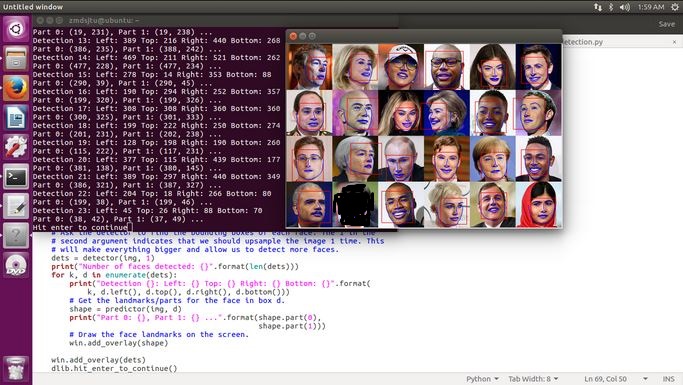环境配置参考:http://www.linuxdiyf.com/linux/31028.html
惯例先放效果图:

这里需要先下载landmark的模型
地址:http://dlib.net/files/shape_predictor_68_face_landmarks.dat.bz2
新建fr.py(其实就是example里的例子,但把限定的jpg格式去掉了,所以需要手动输入后缀名)
#!/usr/bin/python
# The contents of this file are in the public domain. See LICENSE_FOR_EXAMPLE_PROGRAMS.txt
#
# This example program shows how to find frontal human faces in an image and
# estimate their pose. The pose takes the form of 68 landmarks. These are
# points on the face such as the corners of the mouth, along the eyebrows, on
# the eyes, and so forth.
#
# This face detector is made using the classic Histogram of Oriented
# Gradients (HOG) feature combined with a linear classifier, an image pyramid,
# and sliding window detection scheme. The pose estimator was created by
# using dlib's implementation of the paper:
# One Millisecond Face Alignment with an Ensemble of Regression Trees by
# Vahid Kazemi and Josephine Sullivan, CVPR 2014
# and was trained on the iBUG 300-W face landmark dataset.
#
# Also, note that you can train your own models using dlib's machine learning
# tools. See train_shape_predictor.py to see an example.
#
# You can get the shape_predictor_68_face_landmarks.dat file from:
# http://dlib.net/files/shape_predictor_68_face_landmarks.dat.bz2
#
# COMPILING/INSTALLING THE DLIB PYTHON INTERFACE
# You can install dlib using the command:
# pip install dlib
#
# Alternatively, if you want to compile dlib yourself then go into the dlib
# root folder and run:
# python setup.py install
# or
# python setup.py install --yes USE_AVX_INSTRUCTIONS
# if you have a CPU that supports AVX instructions, since this makes some
# things run faster.
#
# Compiling dlib should work on any operating system so long as you have
# CMake and boost-python installed. On Ubuntu, this can be done easily by
# running the command:
# sudo apt-get install libboost-python-dev cmake
#
# Also note that this example requires scikit-image which can be installed
# via the command:
# pip install scikit-image
# Or downloaded from http://scikit-image.org/download.html.
import sys
import os
import dlib
import glob
from skimage import io
if len(sys.argv) != 3:
print(
"Give the path to the trained shape predictor model as the first "
"argument and then the directory containing the facial images.\n"
"For example, if you are in the python_examples folder then "
"execute this program by running:\n"
" ./face_landmark_detection.py shape_predictor_68_face_landmarks.dat ../examples/faces\n"
"You can download a trained facial shape predictor from:\n"
" http://dlib.net/files/shape_predictor_68_face_landmarks.dat.bz2")
exit()
predictor_path = sys.argv[1]
faces_folder_path = sys.argv[2]
detector = dlib.get_frontal_face_detector()
predictor = dlib.shape_predictor(predictor_path)
win = dlib.image_window()
for f in glob.glob(os.path.join(faces_folder_path)):
print("Processing file: {}".format(f))
img = io.imread(f)
win.clear_overlay()
win.set_image(img)
# Ask the detector to find the bounding boxes of each face. The 1 in the
# second argument indicates that we should upsample the image 1 time. This
# will make everything bigger and allow us to detect more faces.
dets = detector(img, 1)
print("Number of faces detected: {}".format(len(dets)))
for k, d in enumerate(dets):
print("Detection {}: Left: {} Top: {} Right: {} Bottom: {}".format(
k, d.left(), d.top(), d.right(), d.bottom()))
# Get the landmarks/parts for the face in box d.
shape = predictor(img, d)
print("Part 0: {}, Part 1: {} ...".format(shape.part(0),
shape.part(1)))
# Draw the face landmarks on the screen.
win.add_overlay(shape)
win.add_overlay(dets)
dlib.hit_enter_to_continue()
运行程序
Python fr.py + 68点dat模型+含后缀的图片路径
python fr.py shape_predictor_68_face_landmarks.dat 1.jpeg
然后就是结果图咯。


